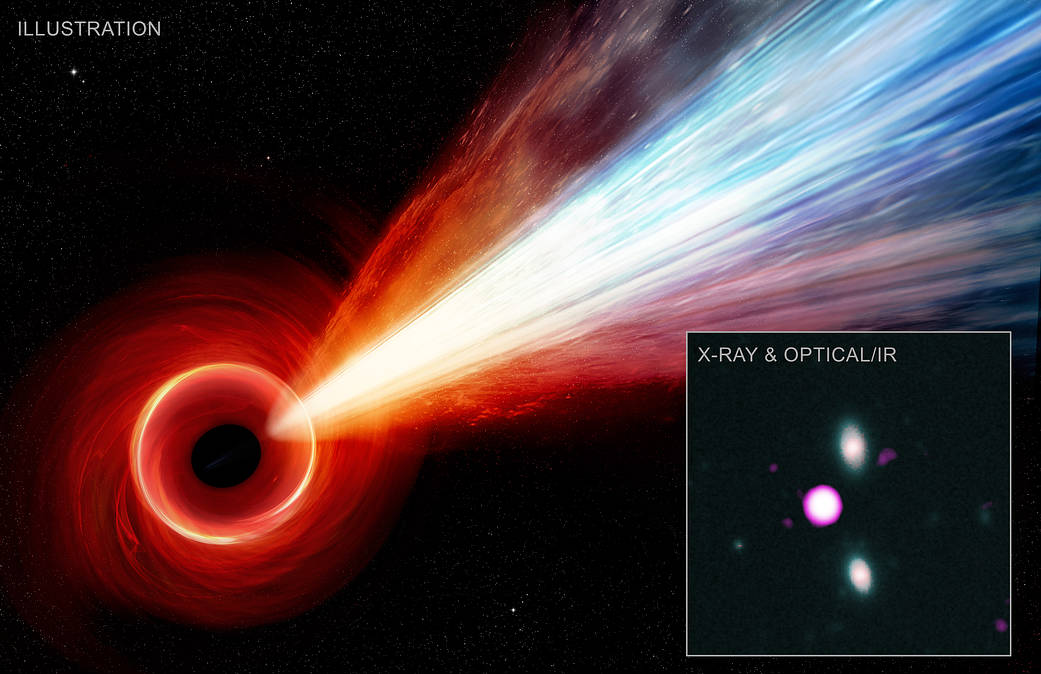This jet from a monster black hole is so huge it dwarfs our Milky Way galaxy

A space telescope spotted a distant supermassive black hole spurting an X-ray jet.
Astronomers using NASA's Chandra X-ray Observatory found the jet coming from an object roughly 12.7 billion light-years from Earth, which is pretty early in the universe's 13.77-billion-year-old history. If confirmed, this would be one of the farthest jet-shooting objects of its kind yet known.
The jet comes from an object known as a quasar, which are active galactic nuclei that feed off of supermassive black holes and can emit extraordinary amounts of energy. Astronomers hope that by studying the jet, called PSO J352.4034-15.3373 (PJ352-15 for short), they can learn how huge black holes came together so early in the universe's history.
Related: The universe: From the Big Bang to now in 10 easy steps
"Despite their powerful gravity and fearsome reputation, black holes do not inevitably pull in everything that approaches close to them," NASA explained in a statement March 9.
"Material orbiting around a black hole in a disk needs to lose speed and energy before it can fall farther inwards to cross the so-called event horizon, the point of no return. Magnetic fields can cause a braking effect on the disk as they power a jet, which is one key way for material in the disk to lose energy and, therefore, enhance the rate of growth of black holes," the statement continued.
Astronomers peered at PJ325-15 for three days using Chandra, which is optimized for X-ray observations. The jet stretches about 1.5 times as long as the Milky Way, measuring a distance of roughly 160,000 light-years away from the quasar. (The Milky Way is roughly 100,000 light-years across.)
Get the Space.com Newsletter
Breaking space news, the latest updates on rocket launches, skywatching events and more!
The jet far surpasses the longest one ever spotted from the first billion years after the Big Bang that formed the universe which was a relative squeaker at only 5,000 light-years in length, NASA said. PJ325-15 is also roughly 300 million light-years further from Earth than any jet ever before spotted.
"The length of this jet is significant because it means that the supermassive black hole powering it has been growing for a considerable period of time," said study co-author Eduardo Bañados, a staff astronomer at the Max Planck Institute for Astronomy in Germany, in the same statement.
"Around supermassive black holes," stated study leader Thomas Connor, a NASA postdoctoral fellow at NASA's Jet Propulsion Laboratory in California, "we think jets can take enough energy away so material can fall inward and the black hole can grow."
A paper based on the research is available on the preprint website Arxiv and has also been accepted for publication in The Astrophysical Journal.
Follow Elizabeth Howell on Twitter @howellspace. Follow us on Twitter @Spacedotcom and on Facebook.
Join our Space Forums to keep talking space on the latest missions, night sky and more! And if you have a news tip, correction or comment, let us know at: community@space.com.

Elizabeth Howell (she/her), Ph.D., was a staff writer in the spaceflight channel between 2022 and 2024 specializing in Canadian space news. She was contributing writer for Space.com for 10 years from 2012 to 2024. Elizabeth's reporting includes multiple exclusives with the White House, leading world coverage about a lost-and-found space tomato on the International Space Station, witnessing five human spaceflight launches on two continents, flying parabolic, working inside a spacesuit, and participating in a simulated Mars mission. Her latest book, "Why Am I Taller?" (ECW Press, 2022) is co-written with astronaut Dave Williams.









